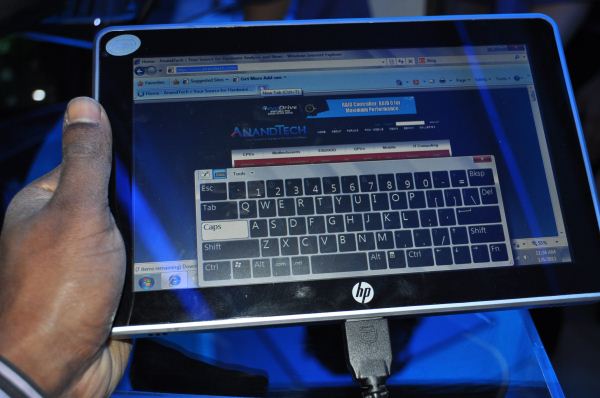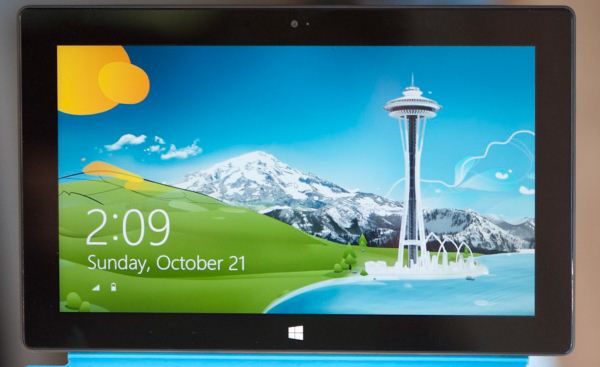The Windows RT Review
by Vivek Gowri & Anand Lal Shimpi on October 25, 2012 12:00 PM EST- Posted in
- Windows RT
- Operating Systems
- Microsoft
- Mobile
- Windows 8
- Tablets
Meet Windows RT
Microsoft’s first serious foray into tablets came just after the turn of the new millenium, with Bill Gates demonstrating the first tablet PC prototype onstage at Comdex in the autumn of 2000. From there, OEMs started releasing tablets based on Windows XP Tablet PC Edition in 2002, with a full range of pen-enabled slates and convertibles releasing over the next few years. In addition to oftentimes prohibitive cost, each had its own set of drawbacks. Convertibles tended to be quite bulky compared to their notebook counterparts (the ThinkPad X-series being a notable exception), while slates were rather difficult to use - a symptom of shoehorning a desktop operating system into a purely touch-centric form factor.
Fast forward a decade, to the beginning of 2010. After a number of conceptual non-starters in the tablet PC space - building tablet PC support into all editions of Windows Vista and 7 (other than Basic/Home Starter), the entire Origami class of devices - Microsoft’s touchscreen devices were floundering. The iPad had been announced to mixed reaction but an extremely high level of anticipation. Microsoft and HP countered with the Slate 500, an Atom-based device shown off at CES 2010 with solid state storage and Windows 7 in roughly the same form factor as Apple’s iPhone OS-based ARM tablet. With speculation pointing to a pricetag of just $549, the Slate appeared to be the most viable hope Microsoft had in trying to make mainstream headway with the tablet PC concept. But shortly after the iPad shipped in April 2010, rumors of the Slate’s demise started to circulate, and after a six month delay, the Slate 500 started shipping as an enterprise-only product in December of that year for $799. HP’s acquisition of Palm (RIP) definitely played a role in the sidelining of the Slate, but more importantly, it essentially spelled the end for the tablet PC. This was news that was perhaps known already, but the Slate saga officially pulled the plug on Microsoft’s original idea of what a tablet was.
The problem was two parts software, one part hardware. Microsoft had developed a very interesting touch-oriented user interface for its handhelds, so at least one part of the equation was relatively straightforward. The hardware issue came down to this: the iOS and Android tablets succeeding in the market ran off ARM system-on-chips, which resulted in slim, power-efficient tablets that had idle times stretching for days. At the time, there was just nothing in terms of x86 hardware that could compete with that in low-power device realm (Clover Trail and Haswell, of course, change this part of the story considerably). The other question? How to converge the touch-centric UI with the classic desktop environment that had been the corner of Windows dating all the way back to 95.
Meet Windows RT. It’s Microsoft’s first major foray into the modern tablet market, the shipping version of Windows-on-ARM, and it’s one of Microsoft’s most important product launches ever. Windows 8 shares the same touch-friendly user interface, but the ARM silicon makes RT an almost entirely tablet-centric operating system, the first for Microsoft. Combined with the focus on premium hardware experiences, this is Redmond’s most serious push to be competitive with the iOS and Androids of the world. How does it fare? Keep reading.












233 Comments
View All Comments
Sherlock - Friday, October 26, 2012 - link
IMHO WIndows RT on ARM is an stop-gap solution till the x86 architecture becoms power efficient to give tablet like running times. I belive Microsoft began working on Surface about two years ago & at that point of time, there was no viable competitor to ARM, in terms of power efficiency. This is the primary reason I belive Microsoft had to create an ARM version.Several of the commentators on this site have mentioned that they see no reason to buy an ARM over x86...and it definitley makes sense. Why have an fragmented ecosystem?
I believe that as time passes on & people get used to the Modern UI & the x86 architecture catches up, Microsft would phase out their support for the ARM version.
Microsoft could have chosen to do away with the "Desktop" environment with Windows RT & created a Moder UI version of Office (I don't agree with the argument of they not having enough time...they have been at it for 2 years) but I guess they deliberately chose to retain it so that users experience the familiar environment while using their killer app in this war - Office. I think people have underestimated the importance of bundling Office with Windows RT which remediates the biggest shortcoming of Android/iOS tablets
prdola0 - Friday, October 26, 2012 - link
Hi, the article is nice, but I keep wondering about one thing. Why do Apple articles start with a nice and colorful image of the devices, and a lot of it's competition articles start with a smudgy ugly images or devices turned off? Maybe it's just accidental, but please give it a thought. It looks a bit like bias.B3an - Friday, October 26, 2012 - link
Lol i've said this before! They often put more effort in to images taken of Apple stuff, which i've never liked as it's bias in way.But to be fair, this time the image at the start of this article is old and to show the Win 7 tablet. It makes sense to have it with the opening of the article.
beginner99 - Friday, October 26, 2012 - link
...but doubtful very usable in practice. I really like the thinking behind Surface with the touch keyboard cover and other things. According to this review Windows 8 isnt that bad on tablets. I'm just gonna believe that.However the Application load times are very, very bad. 7 sec for mail app? That is just frustrating. Just shows that ARM is still very much underpowered....Or that surface uses an extremely crappy flash storage.
milkod2001 - Friday, October 26, 2012 - link
@prdola0this site belongs to Anand a trully Apple fanboy plus there's no such thing as unbiased review, any review on any web is only as good/positive as much is reviewer/site owner getting pay
yyrkoon - Sunday, October 28, 2012 - link
Funny, I thought the review was rather in favor for Microsoft. This review, and the Microsoft surface review. Both.Anand is no dumbie.. I absolutely HATE anything Apple based on pure personal beliefs / reasoning. Yet, even I, can not deny that iOS as far as polish goes is second to none. Until now. And the hardware used is usually top quality.
At a higher cost, with less freedom, and a strangle hold on their software regime. A lot of people claim these are all problems from Microsoft. Which may be true, but Apple trumps Microsoft in computer-land tyranny. Until now.
It could be that 90% of the market will be driven to using Mint Linux x, in the not so distant future. We'll see if Microsoft gets another clue.
GnillGnoll - Friday, October 26, 2012 - link
I very much like that the on-screen keyboard has cursor keys, even if it's just left/right. It's one of the main features missing from the iOS keyboard, as precisely positioning the cursor with your finger is a huge pain.I assume that Ctrl+Left/Right skips words, and that Shift+Left/Right can be used for selection. Does anyone know if there is a way to go up/down?
I don't like that quick access to punctuation is so limited, though.
bitbank - Friday, October 26, 2012 - link
From your comments throughout the article, it's clear that you're a fan of Metro and you overlook many of the shortcomings of Windows Phone and Windows RT just because of the "smooth tiled interface". The truth is that the GUI isn't that important. It's not where you get your work done. Apps are where you work.As you said, an ARM version of Windows is good to wake Intel from their slumber and get some competition in the low cost/low power CPU market. Intel's Sandy Bridge and Ivy Bridge processors get decent battery life and run 3-5x faster than the best ARM offerings to date. I get 8-10 hours of battery life out of my 17" HP Sandy Bridge notebook with the medium capacity battery. I would much rather have an x86 slate running Windows 8 with support for legacy apps. Having a half-baked version of Office on an ARM based WinRT tablet isn't much incentive to be stuck with virtually no apps.
WindowsRT feels a lot like the launch of Windows CE notebooks. Interesting form factors and improved battery life don't make up for lack of app compatibility. The value of Windows is in its huge selection of apps. Win8 Pro is taking the right approach. Similar to the transition from DOS and 16-bit to 32-bit apps with Windows 95, there needs to be a transition product (Win8 Pro) which bridges the gap between old and new. When presented with a completely new device with no legacy support and very little app support, it makes very little sense for the average user to buy it. Besides reviewers and people who have to buy the latest gadget, why should an average person want to buy WinRT? According to you, they should patiently wait for the app store to get some decent apps. That's asking too much. The smart move for the average consumer is to wait a year or so and see if developers have given any attention to Windows 8's "little brother" and published apps in both x86 and ARM versions.
karocage - Friday, October 26, 2012 - link
But the interface is how you navigate all those apps. It's legitimate to point out that WP7 and W8/RT have clearly surpassed iOS in terms of speed of navigation between things like the back button, hubs, task switcher, charms and so on. That's not a function of the tiles really - although of course the tiles are another place where MS has a much better implementation than Apple.steven75 - Friday, November 2, 2012 - link
Completely disagree on speed of navigation. Are you familiar with the four-finger swipes on an iPad to switch apps, bring up the "task manager" tray, etc?I'll give you getting to the settings screen to find apps settings takes longer but thankfully on iOS apps launch lightning fast unlike on RT.